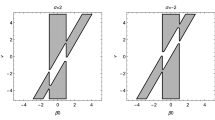Abstract
We review recent results concerning the spherically symmetric Einstein-scalar field system with positive cosmological constant. We do so by comparing with the classical results of Christodoulou concerning the asymptotically flat case (vanishing cosmological constant) and by discussing some of the issues which have emerged since the publication of our main results. Concerning the positive cosmological constant case, we also sketch an alternative proof of global in (Bondi) time existence, based on energy estimates, which is presumably more flexible and, consequently, amenable to generalizations; other potential improvements and generalizations of our main results are also discussed.


Similar content being viewed by others
Notes
The setup described in Sect. 2 works for any value of \(\Lambda \), and to recover the original asymptotically flat case one only has to set \(\Lambda =0\). Nonetheless, recall that Christodoulou fixes his \(u\)-coordinate by demanding that \(f(u,r=\infty )\equiv 1\), i.e., the clock is set by the observers at infinity rather then the observers at the origin, as used in this paper, with the exception of the present section where the original gauge fixing is considered.
A Banach space is a complete normed vector space, complete meaning that every Cauchy sequence is convergent.
One should also note that when comparing these estimates with (23), their \(\Lambda =0\) analogs, they appear reversed as a consequence of the already mentioned difference in the gauge fixing of \(u\).
In fact all that is needed to carry out the argument to follow is a somewhat less orthodox local existence result for initial data with (arbitrary) finite \(\Vert h_0\Vert _{{{\mathcal {C}}}_R}\) and small \(\Vert \partial _rh_0\Vert _{{{\mathcal {C}}}_R}\). Such result has the advantage of following from the arguments in [8] leading to the local existence result there.
If one considers instead a local existence theorem for finite \(\Vert h_0\Vert _{{{\mathcal {C}}}_R}\) and small \(\Vert \partial _rh_0\Vert _{{{\mathcal {C}}}_R}\) the previous extension principle has to be reformulated accordingly: for a given \(\bar{{\mathcal {E}}}_1>0\), then \(U^*=\infty \) or \({{\mathcal {E}}}_0\) is unbounded in \([0,U^*)\) or \(\sup _{u\in [0,U^*)}{{\mathcal {E}}}_1(u)>\bar{{\mathcal {E}}}_1\).
References
Beyer, F.: The cosmic no-hair conjecture: a study of the Nariai solutions. In: Damour, T., Jantzen, R.T., Ruffini, R. (eds.) Proceedings of the Twelfth Marcel Grossmann Meeting on General Relativity
Christodoulou, D.: Global existence of generalized solutions of the spherically symmetric Einstein scalar equations in the large. Commun. Math. Phys. 106, 587–621 (1986)
Christodoulou, D.: The problem of a self-gravitating scalar field. Commun. Math. Phys. 105, 337–361 (1986)
Christodoulou, D.: A mathematical theory of gravitational collapse. Commun. Math. Phys. 109, 613–647 (1987)
Christodoulou, D.: The structure and uniqueness of generalized solutions of the spherically symmetric Einstein scalar equations. Commun. Math. Phys. 109, 591–611 (1987)
Christodoulou, D.: The formation of black holes and singularities in spherically symmetric gravitational collapse. Comm. Pure Appl. Math. 44, 339–373 (1991)
Christodoulou, D.: The formation of black holes in general relativity. EMS Monographs in Mathematics. arXiv/gr-qc:0805.3880 (2009)
Costa, J.L., Alho, A., Natário, J.: The problem of a self-gravitating scalar field with positive cosmological constant. Annales Henri Poincaré (To appear)
Costa, J.L., Alho, A.: Spherical linear waves in de Sitter spacetime. J. Math. Phys. 53, 052501 (2012)
Dafermos, M., Rodnianski, I.: A proof of Price’s law for the collapse of a selfgravitating scalar field. Invent. Math. 162, 381–457 (2005)
Gustav, H., Jacques, S.: Self-gravitating Klein–Gordon fields in asymptotically Anti–de-Sitter spacetimes. Annales Henri Poincare 13, 991–1038 (2012)
Gustav, H., Jacques, S.: Stability of Schwarzschild-AdS for the spherically symmetric Einstein–Klein–Gordon system. Commun. Math. Phys. 317, 205–251 (2013)
Rendall, A.D.: Fuchsian methods and space-time singularities. Class. Quant. Grav. 21, S295–S304 (2004)
Ringström, H.: Future stability of the Einstein-non-linear scalar field system. Invent. Math. 173, 123–208 (2008)
Ringström, H.: The cauchy problem in general relativity. Lectures in Mathematics and Physics, European Mathematical Society (2009)
Acknowledgments
We thank Simone Calogero, Piotr Chruściel, Mihalis Dafermos, Marc Mars, Filipe Mena, José Natário, Raül Vera, Alan Rendall and Hans Ringström for useful discussions and comments. Special thanks are due to J. Natário for various comments concerning a preliminary version of this work. The author would like to acknowledge the hospitality afforded to him by the Department of Pure Mathematics and Mathematical Statistics of the University of Cambridge, as well as by the Erwin Schrödinger Institute (Vienna), during the workshop “Dynamics of General Relativity: Black Holes and Asymptotics”. This work was partially supported by project CERN/FP/116377/2010.
Author information
Authors and Affiliations
Corresponding author
Additional information
This article belongs to the Topical Collection: Progress in Mathematical Relativity with Applications to Astrophysics and Cosmology.
Rights and permissions
About this article
Cite this article
Costa, J.L. The spherically symmetric Einstein-scalar field system with positive and vanishing cosmological constant: a comparison. Gen Relativ Gravit 45, 2415–2440 (2013). https://doi.org/10.1007/s10714-013-1611-0
Received:
Accepted:
Published:
Issue Date:
DOI: https://doi.org/10.1007/s10714-013-1611-0




